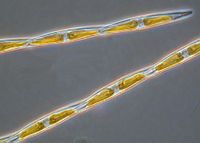
Photo from wikipedia
Abstract The Gulf of Gabes, pole of shellfish production in Tunisia, is known by a great maritime traffic. The objective of the present study is to update the planktonic organisms… Click to show full abstract
Abstract The Gulf of Gabes, pole of shellfish production in Tunisia, is known by a great maritime traffic. The objective of the present study is to update the planktonic organisms listing and to screen alien and harmful planktonic species in the Gulf. The investigations, conducted in the four commercial ports of the Gulf of Gabes, in 2010, revealed the presence of 138 phytoplankton taxa dominated by the Dinophyceae and Bacillariophyceae and 37 Dinophyceae rest forms from which 17 were not found in their active form. Among the alien phytoplankton species in the Mediterranean, we identified 4 species in water and 6 Dinophyceae cysts taxa in sediments of the Gulf of Gabes. The four encysted forms of potentially toxic dinoflagellates, detected in this work, were wholly non-indigenous species. Eleven known harmful phytoplanktonic species, including 2 native species of Diatoms (Chaetoceros socialis and Pseudo-nitzschia sp.) and 9 Dinophyceae including the non-indigenous species Alexandrium minutum and Karenia selliformis were found during this study. The qualitative analysis of zooplankton in the gulf of Gabes showed the common presence of 21 groups which the most important is copepods. It revealed also the presence of the two Alien species Acartia (Acanthacartia) bifilosa and Paracartia (Acartia) grani.
Journal Title: Regional Studies in Marine Science
Year Published: 2019
Link to full text (if available)
Share on Social Media: Sign Up to like & get
recommendations!